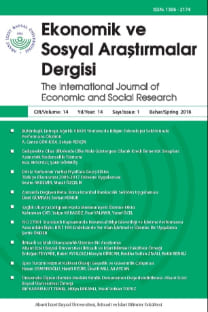İNŞAAT SEKTÖRÜNDEKİ BÜYÜME İLE EKONOMİK BÜYÜME ARASINDAKİ İLİŞKİ SÜRDÜRÜLEBİLİR Mİ?
THE CONSTRUCTION SECTOR AND ECONOMIC GROWTH: A SUSTAINABLE RELATIONSHIP?
___
- Alhowaish, A. K. (2015). “Causality between the construction sector and economic growth: the case of Saudi Arabia.” International Real Estate Review, 18(1), 131-147.
- Aschauer, D. A. (1989). Is public expenditure productive?. Journal of Monetary Economics, 23, 177-200.
- Banaitienė, N., Banaitis, A., Laučys, M. (2015). Foreign direct investment and growth: analysis of the construction sector in the Baltic States. Journal of Civil Engineering and Management 21(6), 813-826.
- Eurostat (2012), https://ec.europa.eu/eurostat/publications/statistical-reports
- Giang, D.T.H., Pheng, L.S. (2011). Role of construction in economic development: Review of key concepts in the past 40 years. Habitat International, 35(1), 118-125.
- Gregory, A. W., & Hansen, B. E. (1996). Residual-based tests for cointegration in models with regime shifts. Journal of econometrics, 70(1), 99-126.
- Gruneberg, S. L. (1997). Construction economics: An introduction. Basingstoke:Macmillan.
- Hatemi-J, A. (2008). Tests for cointegration with two unknown regime shifts with an application to financial market integration, Empir Econ, 35, 497–505.
- Kapelko, M., Lansink, A. O., Stefanou, S. E. (2014). Assessing dynamic inefficiency of the Spanish construction sector pre-and post-financial crisis. European Journal of Operational Research, 237(1), 349-357.
- Kaya, V. Yalçınkaya, Ö. Huseyni, İ. (2013). Role of Construction Sector in Economic Growth: The Case of Turkey (1987-2010) , Atatürk University Journal of Economics and Administrative Sciences, 27(4), 148-168.
- Kildienė, S., Kaklauskas, A. Zavadskas, E.K. (2011) COPRAS based Comparative Analysis of the European Country Management Capabilities within the Construction Sector in the Time of Crisis. Journal of Business Economics and Management, 12(2), 417-434.
- Lean, C. S. (2001). Empirical tests to discern linkages between construction and other economic sectors in Singapore. Construction Management and Economics, 19, 355–363.
- Lee, J., Strazicich, M. C. (2003 ). Minimum lagrange multiplier unit root test with two structural breaks. The Review of Economics and Statistics, 85(4), 1082-1089.
- Lee, J., Strazicich, M. C. (2004). Minimum LM unit root test with one structural break. Manuscript, Department of Economics, Appalachian State University: 1-16.
- Majdalani, Z., Ajam, M., Mezher, T. (2006). Sustainability in the construction industry: a Lebanese case study. Construction Innovation, 6(1), 33-46.
- Ofori, G. (1990). The construction industry: aspects of its economics and management. NUS Press.
- Oladinrin, T. O., Ogunsemi, D. R. and Aje, I. O., (2012). “Role of construction sector in economic growth: empirical evidence from Nigeria” FUTY Journal of the Environment ,7(1), 50-60.
- Ozkan, F., Ozkan, O., Gunduz, M. (2012). Causal relationship between construction investment policy and economic growth in Turkey. Technological Forecasting & Social Change, 79, 362–370.
- Ramachandra, T., Rameezdeen, R. (2006). Study of the relationship between construction sector and the Sri Lankan economy.” Built-Environment-Sri Lanka, 6(2), 50-56.
- Robin, C.P.Y., Poon, C.S. (2009) Cultural shift towards sustainability in the construction industry of Hong Kong. Journal of Environmental Management, 90(11), 3616-3628.
- Ruddock, L., Lopes, J. (2006). The construction sector and economic development: the ‘Bon curve’. Construction Management and Economics, 24(7), 717-723
- Strassmann, P. (1970). The construction sector in economic development. Scottish Journal of Political Economy, 17(3), 390-410.
- Tse, R.Y.C., Ganesan, S. (1997). Causal relationship between construction flows and GDP: evidence from Hong Kong. Construction Management and Economics, 15(4), 371-376.
- Turin, D. A. (1969). The construction industry: Its economic significance and its role in development. London: University College, Environmental Research Group.
- Wells, J. (1985). The role of construction in economic growth and development, Habitat International, 9(1), 55-70
- Wilhelmsson, M., Wigren, R. (2009). The robustness of the causal and economic relationship between construction flows and economic growth: evidence from Western Europe. Applied Economics 1-10.
- Wylie, P. J. (1996). Infrastructure and Canadian economic growth 1946-1991. The Canadian Journal of Economics, Special Issue: Part 1, 350-355.
- Zheng, S., & Liu, H. (2004). Interaction among construction investment, other investment and GDP in China. Tsinghua Science and Technology, 9(2), 160-167.
- Zivot, E., Andrews, D. W. K. (1992). Further Evidence on the Great Crash, the Oil- Price Shock and the Unit Root Hypothesis. Journal of Business and Economic Statistics, 10, 251-270.
- ISSN: 1306-2174
- Yayın Aralığı: 2
- Başlangıç: 2005
- Yayıncı: Abant İzzet Baysal Üniversitesi İktisadi ve İdari Bilimler Fakültesi
THE CONSTRUCTION SECTOR AND ECONOMIC GROWTH: A SUSTAINABLE RELATIONSHIP?
BOLU İLİNİN TERMAL TURİZM AÇISINDAN POTANSİYELİNİN DEĞERLENDİRİLMESİ
Melis ERÇİN YURCU, Canan ERYİĞİT
TÜRKİYE’DEKİ YABANCI MENŞELİ ÜNİVERSİTE TERCİHİNDE KİŞİSEL VE BÖLGEYE YÖNELİK FAKTÖRLERİN ROLÜ
Bahtışen KAVAK, Niray TUNÇEL, Şerife KAZANCI SUNAOĞLU, Öznur ÖZKAN TEKTAŞ
İNŞAAT SEKTÖRÜNDEKİ BÜYÜME İLE EKONOMİK BÜYÜME ARASINDAKİ İLİŞKİ SÜRDÜRÜLEBİLİR Mİ?
ÇAPALAMA ETKİSİ: EFSANE Mİ YOKSA GERÇEK Mİ?
ENDÜSTRİYEL AĞAÇ VE AHŞAP ÜRÜNLERİ SEKTÖRÜNÜN ULUSLARARASI REKABET GÜCÜ ANALİZİ: TÜRKİYE ÖRNEĞİ
Oğuz KARA, Özkan ŞAHİN, İlter BEKAR, Bekir KAYACAN
GİRİŞİMCİLİK VE EKONOMİK BÜYÜME ARASINDAKİ NEDENSELLİK İLİŞKİSİ: TÜRKİYE ÖRNEĞİ
